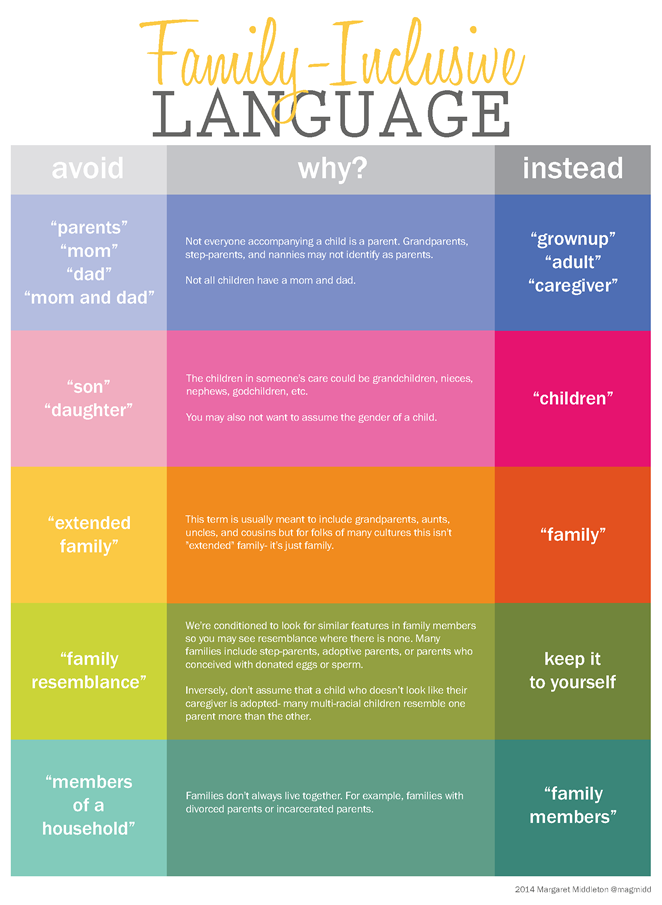
Speaking of Inclusivity
By Margaret Middleton, Exhibit Designer, Boston Children’s Museum
Museums are very interested in inclusivity and that’s reflected in most current museum mission statements. But a museum’s choice of words on a day-to-day basis has the power to undermine even the most carefully penned mission statement. And it can’t be controlled with a single sentence on a website. The Museum Voice needs to reinforce the mission with consistently inclusive language. That’s why it’s so important for every museum to adopt an inclusive language strategy. Without it, all that good intention is irrelevant.
What is the Museum Voice?
The Museum Voice is everything communicated by the museum: written, spoken, and visual. This includes (but is not limited to) interpretive panels, marketing, membership forms, wayfinding, press releases, tweets, admissions scripts and tour guide patter. Whether they are aware of it or not, anyone at the museum who communicates with the public contributes to the Museum Voice.
What Inclusive Language Is
This is where inclusive language comes in. Inclusive language strategies are designed to welcome all visitors (and staff) by promoting a culture of intentionality around word choice. Inclusive language does not assume race, ethnicity, gender identity, sexual orientation, nationality, class, level of education, etc. In short, inclusive language is about checking assumptions and recognizing personal biases.
What Inclusive Language Is Not
This isn’t about policing language or shaming anyone. It’s about analyzing words and their meanings and thinking critically about how every staff member’s words combine to form the Museum Voice which must reflect the mission of the museum.
How to Implement Inclusive Language
Intrigued? Here’s a case study. As a children’s museum professional I’m particularly interested in how my museum can welcome all kinds of families. Starting with that one aspect of inclusivity, I worked with two of my colleagues to unpack all the assumptions and biases we saw made about the meaning of family. Together we developed the term “21st Century Family”.
21st Century Family n.
- A family as defined by the individuals involved, inclusive across race, culture, gender, age, and marital status. Family members may or may not be biologically related, share the same household, or be legally recognized.
- As opposed to “nuclear family.”
This definition was devised not to suggest that families themselves have changed, but that time and again the word “family” is used as a code word for a nuclear family with two heterosexual legally married parents of the same race and their biological children, residing in the same household. Yet, according to Strong Families, “4 out of 5 people living in the US … do not live behind the picket fence—[their] lives fall outside outdated notions of family, with a mom at home and a dad at work.” Museums who don’t actively engage 21st Century Families aren’t serving the majority of families so it is critical that museum staff are all on the same page when they use the word “family.”
From here, I developed the Family Inclusive Language guide. I used the definition of 21st Century Family to think about the ways some word choices are more inclusive than others and how other word choices are downright alienating.

When I presented this chart (click here to download a pdf) at AAM15 with Rose Paquet Kinsley and Porchia Moore of the Incluseum, our participants were inspired to use the chart as a model to interrogate other commonly used phrases in their museums. Imagine taking language like “community engagement” or “underserved populations,” defining what is really being said and coming up with more accurate, inclusive alternatives.
“That’s so easy! I can do that.”
The most common feedback I get when I talk about inclusive language is, “That’s so easy! I can do that.” And it’s completely true. But just because it’s easy doesn’t mean it’s superficial. Words have power and by making a commitment to being deeply intentional with language a museum can cultivate a Museum Voice, and inevitably an institutional culture, that harnesses that power to reflect and support the mission.
Margaret Middleton presented on this topic in the session "Gender and Sexuality at the Museum: Inclusive Practice for Visitors and Staff" on Thursday, November 6 during the 2015 NEMA conference.